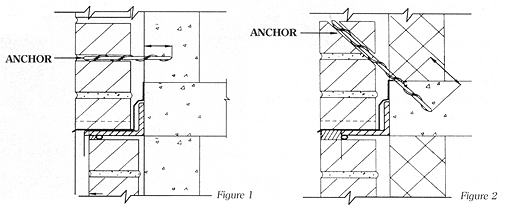Every project is unique and the Quality Hotel project in London was no exception. A key challenge for the contractor was to execute the large scope of work while minimizing disruption of the day-to-day operations of the Hotel. In addition, installation of wall ties at an acute angle into the floor slabs made for an uncommon challenge. To minimize disturbances to the Hotel and control production costs, the contractor devised a strategic solution enabling the efficient performance of diverse tasks by a small, elite crew of trained personnel. The success of this story was the solid partnership of owner, consultant, tie-manufacturer and contractor, working together toward a common goal: the successful retrofit of a previously deficient cavity wall system.
Quality Hotel, London, Ontario uses unique approach to reinforce exterior masonry cladding
The Quality Hotel, a ten storey hotel at 374 Dundas Street, London, Ontario, was built in 1987. When the building was only five years old, distress of the brick veneer began to cause concern. Cracking and spalling of the brick led to an investigation of the exterior wall construction.
The building’s construction is reinforced concrete flat plate and structural shearwalls with a masonry cladding. The cladding generally consists of a 4-inch brick wythe attached to a 4-inch block wythe with masonry joint reinforcing used to create a composite wall. The 4-inch block wythe is supported between the concrete floor plates and the brick veneer is supported on steel shelf angles at every floor. The end walls consist of a brick veneer tied back with standard dovetail anchor ties, through large cavities (up to 212 inches wide) to the concrete shearwalls, and supported on shelf angles at every floor.
After the investigation, the consultants proposed a repair solution that used brick ties and structural steel framing which required concealment in a stud and drywall partition for 80% of the exterior wall area. Also, soft joints were to be added at shelf angles. This work required access from the exterior and interior of the building to the whole exterior wall. Although effective, the solution was disruptive and expensive.
Mr. Pat Hayes, Director of Maintenance and Repairs for Journey’s End Corporation, had heard of a technique for load testing developed by Dinal Services Inc. (the research arm of J. Stuart Hall & Associates Ltd.). The Dinal Load testing technique was developed to provide in-situ load testing of brick and stud wall assemblies. A section of wall is isolated and a jacking assembly is used to perform push and pull forces to the wall assembly. These tests establish stiffness and strength characteristics of both the existing wall and the reinforced wall, based upon the research carried out at McMaster University by Dr. Drysdale to establish composite wall characteristics.
From the test results, a repair strategy was established by J. Stuart Hall & Associates Ltd., that enhanced the composite action of the brick and block wall and provided positive anchorage between the block back-up and the structure. The repair strategy would be done entirely from the exterior and used the “Heli-fix” stainless steel anchors as supplied by “Blok-lok”, in 516 inch and 38 inch diameters, with various lengths. Both wythes were connected by 516 inch ties, placed horizontally as determined by the test program (see figure 1). To provide positive anchorage of the block veneer, 38 inch ties were placed diagonally through the block to engage the structural slab (see figure 2). Significant reduction in the cost of repairs was realised with this solution, some 75%, in addition to minimal disruption of hotel operations.
After competitive tendering, Everest Restoration was selected as the contractor. Inspection of the work was carried out twice weekly by J. Stuart Hall & Associates Ltd.’s inspectors to establish quality control and to control quantities.
The professionalism and experience exhibited by Everest Restoration, exemplified by Mr. Tad Magee, project manager, and Mr. Jacques Landry, Site Foreman has been greatly appreciated by ourselves. All consultants’ work is made easier when experienced and responsible contractors carry out the work.

Article written by Stuart Hall of J. Stuart Hall & Associates Ltd.
254 Friel Street, Ottawa, Ontario.

No Comments